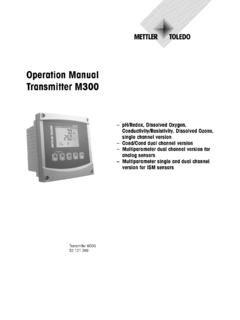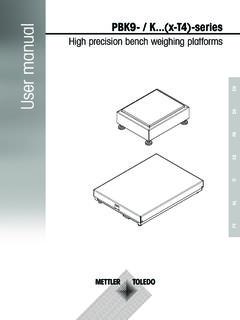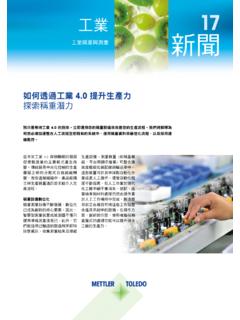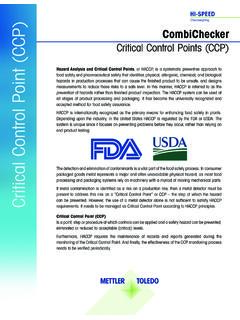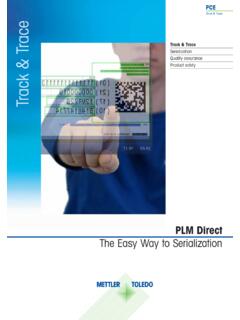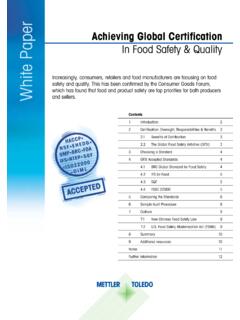Transcription of Pipet-Lite XLS+ Operating Instructions - Mettler Toledo
1 Operating InstructionsPipet-Lite XLS+ Manual Pipettes with RFIDS ingle-channel Multichannel Adjustable Spacer2 Single channel models with LTS or universal-fit shafts Multichannel models with LTS Adjustable spacer multichannel models with LTS RFID enabled, all models Table of Introduction .. Setting Volume .. Tip Selection and Mounting .. Tip Immersion Depth .. Operation .. Tip Ejector Arm Removal .. Storage .. Care and Maintenance .. Autoclaving .. Upgrading your Pipette to XLS+ .. Troubleshooting .. Service, Calibration, and Repair ..11 Replacement Parts .. RFID (Radio-Frequency Identification) .. Pipet-Lite XLS+ Multichannel Pipet-Lite XLS Adjustable Spacing Pipettes .. Specifications All Models ..inside back coverContents of box Pipette model as ordered Conformance Certificate / Warranty CardIf any item is missing please call 800-4-RAININ (800-472-4646) in the US, or contact your local MT office or , Pipet-Lite , XLS, XLS+, LTS, LiteTouch, Hang-Ups are trademarks of Rainin Instrument, LLC.
2 Pipet-Lite pipettes are manufactured under Patent Nos. 5,614,153; 5,700,959; and 5,849,248. For use under patents 6,168,761 B1; 6,171,553 B1; and D426,643. 2017 Mettler - Toledo Rainin, LLC. No part of this manual may be copied without the express written permission of Mettler - Toledo Rainin, XLS and XLS+Manual Pipettes with RFIDP ipet-Lite XLS3 Introduction Rainin s Pipet-Lite XLS and XLS+ family is continually being upgraded with new features to further improve ergonomics while maintaining high accuracy and perfor-mance. The pipette is available in several versions, out-lined below; this manual will describe all models. Single-channel 11 models for volumes from L to 20 mL Multichannel 12 models for volumes from 1 L to 1200 L, including 8 and 12 channels Adjustable-spacer 5 models for volumes from 5 L to 1200 L including 6 and 8 channels, with nozzle spacing adjustable from 9-19 or 9-14 mm. Spring forces are reduced even further over previous models.
3 With a contoured handle with fingerhook, the pipette is designed for maximum comfort and enhanced performance. New enhancements for Pipet-Lite XLS+ single channel include low stiction* seals for incredibly smooth opera-tion and a tough high-density polymer tip ejector that is corrosion free and easy to release in one smooth action. Pipet-Lite XLS+ multichannels are enhanced with low stiction seals and are up to 35% lighter than the previous model with even lower plunger forces. In models with LTS shafts (L-model single channels, all multichannels and adjustable spacers), the patented LTS LiteTouch Tip Ejection System reduces tip ejection forces by up to 85% in the single-channel L models, and provides absolutely consistent sample pickup across all channels in multichannel models, as well as reducing tip ejection force. Finally, all models contain an RFID tag (radio-frequency identification) for facilitating calibration management when using the optional SmartStand and EDPAM soft-ware.
4 *stiction = static frictionFigure 1: Pipet-Lite XLS+ PLUNGER BUTTONVOLUME SETVOLUME LOCKCOUPLING NUTDISPOSABLETIPSHAFTRFID INFINGER-HOOKVOLUME DISPLAYRUGGEDHIGH-IMPACTLOW THERMALCONDUCTIVITYPOLYMERTIP EJECTORTIP EJECTOR BUTTON4 Single-Channel Setting Volume 1. Turn the volume lock lever to the unlock position so the volume setting mechanism is un-locked and free to turn. See left image in Figure 2. UNLOCKLOCK 2. With the mechanism unlocked, orient the pipette so you are looking at the volume indicator, then rotate the plunger button to change volume counter-clockwise to increase, and clock-wise to decrease volume. Read the volume indicator from the top down: 2 20 L: Black digits indicates L. Red digits tenths, hundredths of L. 100 300 l: All digits black L. 1000 5000 L: red digit mL.
5 Black digits tenths, hundedths of mL. 10 mL and 20 mL: Red digit mL. Black digits tenths of mL. 3. To eliminate errors due to mechanical backlash: when setting the desired volume, first turn the knob 1 3 turn above the desired volume. Then turn the knob slowly clockwise until the desired volume is displayed. Always dial down to the desired volume. 4. Turn the volume lock to the lock position (Fig. 2 above) to prevent changes to the volume setting. Some volumes for the 200 L model are shown in Figure 4. Figure 2: Volume Lock ControlFigure 3: Volume Indicator by Pipette ModelFigure 4: Example volumes5 Volume ranges and increments for each model are shown below:Single-Channel Volume Adjustable Range L Recommended Range L Increment L 2 L 0 to 2 to 2 10 L 0 to 10 to 10 20 L 0 to 20 2 to 20 100 L 0 to 100 10 to 100 200 L 0 to 200 20 to 200 300 L 0 to 300 20 to 300 1000 L 0 to 1000 100 to 1000 2000 L 0 to 2000 200 to 2000 5000 L 0 to 5000 500 to 5000 10 mL 0 to 10 mL 1 mL to 10 mL 20 mL 0 to 20 mL 2 mL to 20 mL and Adjustable-Spacers Volume Adjustable Range L Recommended Range L Increment L 10 L 0 to 10 to 10 20 L 0 to 20 2 to 20 50 L 0 to 50 5 to 50 100 L 0 to 100 10 to 100 200 L 0 to 200 20 to 200 300 L 0 to 300 20 to 300 1200 L 0 to 1200 100 to 1200 5000 L, 10 mL, and 20 mL pipettes use a filter in the end of the shaft to help prevent liquid entering the shaft and contaminating the piston, should the plunger snap up during aspiration.
6 Using a filter is recommended when pipetting large volumes. Replace the filter if it gets 5000 L and 10 mL pipettes use the same filter, as shown in the diagram above: 5000 L: small diameter into the shaft. 10 mL: large diameter into the part numbers are 17001944 (pack of 100) and 17001945 (pack of 1000).The filter for the 20 mL model is a cylinder. Part numbers: 17001951 (pack of 100), 17001952 (pack of 500).Figure 5: Filter orientation6 Single-Channel Tip Selection and Mounting Rainin pipettes and tips are designed together as a pipetting system, both in LTS and traditio-nal versions. All Rainin tips are BioClean and totally inert, so you can be assured of the best pipetting results. Rainin pipettes are calibrated with Rainin tips, and performance to published specifications can only be guaranteed when Rainin tips are used. To mount a tip, press the pipette shaft into the end of the tip with light force.
7 With both LTS and traditional versions, the tip will seal properly on the shaft with minimal force do not use more force than is required. Tip Immersion Depth The recommended depth for tip insertion into the sample for each model is shown Volume Volume Range Immersion Depth2 L - 2 L 1-2 mm10 L - 10 L 1-2 mm20 L 2 - 20 L 2 - 3 mm100 L 10 - 100 L 2 - 3 mm200 L 20 - 200 L 3 - 6 mm300 L 20 - 300 L 3 - 6 mm1000 L 100 - 1000 L 3 - 6 mm2000 L 200 - 2000 L 3 - 6 mm5000 L 500 - 5000 L 6 - 10 mm10 mL 1 mL - 10 mL 6 - 10 mm20 mL 2 mL - 20 mL 6 - 10 mmTip immersion depth is critical and should not be exceeded, or the volume measured may be inaccurate, possibly out of specification. The tip angle is also important the pipette should always be used in a position within 20 degrees of vertical. See Figure 6 below. TIPANGLEF igure 6: Tip Immersion Depth and Tip Angle7 Operation Before pipetting valuable samples, it is good to practice aspirating and dispensing water.
8 1. Set the desired volume as described on page 4. 2. Attach a new Rainin tip. Press the shaft into the tip with sufficient force to make a good seal. 3. Press the plunger button to the first stop, and hold it in this position. See the diagram below for a depiction of the first and second stops. Aspiration: 1. Holding the pipette vertically (or within 20 of vertical), place the tip into the sample to the proper depth and relax your thumb pressure on the plunger. The light piston spring will move the piston upward, aspirating sample. Do not let go of the plunger button , or the piston may snap up quickly, resulting in inaccurate measurement. 2. Pause for about 1 second (longer for macro-volume pipettes) to ensure that the full volume of sample is drawn into the tip. 3. Withdraw the tip from the sample. If any liquid remains on the outside of the tip, touch it off carefully onto a lint-free tissue, taking care not to touch the tip orifice.
9 Dispensing: 1. Touch the tip end against the side wall of the receiving vessel and press the plunger slowly, past the first stop, to the second stop, or blowout (bottom of stroke.) Wait: 1 second for 2-300 L volumes, 1-2 seconds for 1000 L and larger. (For viscous solutions pause before blowout.) 2. Still holding the plunger, withdraw the tip, sliding it along the wall of the vessel. Release the plunger. 3. Press the tip ejector button lightly to discard the tip. Use a new tip for each sample to prevent carry-over. Repeat for the next pipetting cycle. Pipetting Guidelines You should maintain: 1. Consistent pickup and dispense rhythm. 2. Consistent speed and smoothness when pipetting. 3. Consistent pressure on the plunger button at the first stop. 4. Consistent immersion depth. See Figure 6. 5. Pipette vertically, or within 20 of vertical. 6. Pre-rinse the tip twice by aspirating and dispensing sample before actual pickup.
10 7. Don t invert or lay the pipette flat with liquid in the information on Good Pipetting Technique, including a Lab Poster, can be found on the Rainin and MT websites: or 102 Figure 7: Neutral position (0), First stop (1), and Second stop (2)8 Single Channel Tip Ejector Arm Removal Four types of tip ejector are used and all types can be removed with minimum effort do not use models up to 2000 L Metal tip ejector: press in the quick-release tabs on the ejector arm and pull the arm tip ejector: grasp firmly on the ejector arm and pull 5000 L & 10 mL models: grasp the top of the ejector arm and pull out then the 20 mL model: pull off the lower part of the ejector arm; the upper part stays in place. (Replace by aligning the rod with the hole in the upper part and pressing firmly.)To replace the ejector arm (except 20 mL described above), insert the shaft through the large opening, align the top of the ejector arm with the tip ejector push-rod, and push the ejector arm firmly until it is securely in place.

